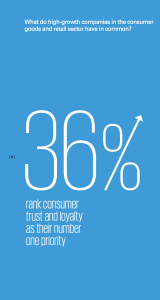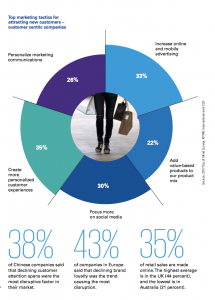The importance of fostering positive relationships between a company and its clients dates as far back as the 1950s, when globally-acclaimed management guru, Peter Drucker [1], set the foundations of customer-relations in businesses for decades to come by stating that “[the] purpose of business is to create and keep a customer.”
Many small-to-medium enterprises find themselves in a less-than-promising position among their competitors when they want to appeal to a pool of risk-adverse consumers who choose to put their trust in larger brands. So, to differentiate themselves from those who are more well-established in their cohort, many enterprises choose to tailor their goods or services to the specific needs of potential consumers.

(Above) Taken from KPMG’s 2017 Top of Mind Survey
After inspection of “The 2017 Top of Mind Survey,” a recent survey conducted by KMPG on 526 senior consumer goods and retail executives, I noticed a steep rise in the number of small-to-medium enterprises that are planning to prioritize their customer service and establish customer trust and loyalty above everything else. Within the disruptive market, 34% of those entities hope to implement a personalized, customer service model to appeal to new customers while another 31% plan to utilize marketing trends, such as online and mobile advertisements, to expand marketing and customer-relations operations [2].

(Above) tactics to increase customer-centricity (taken from KPMG).
According to the American Customer Satisfaction Index (ACSI), investments in improving customer’s experience has only improved by a small margin [3]. The numbers measured at 74.8 in 1994, then dropped to a minimum of 70.7 in 1997, rose to 72.5 at the beginning of the Millennium decade, proceeded to hit an all-time high at 76.8 in 2013–and then receded slightly to 75.4 this year. The numbers surprisingly show that customer satisfaction has only increased by a negligible margin of 0.6 since two decades ago – and 4.7 since the all-time low in 1997. Despite the huge shift for businesses to focus massive resources and capital into improving customer relationships, the statistics haven’t indicated an increase in customers’ satisfaction with the products and services.
After conducting research and taking into account both sides of the topic, I believe that customers aren’t mostly giving businesses a hard time because they are unhappy with the provided products or services. Rather, I believe that consumer behaviors are becoming sporadic and easily influenced by a multitude of factors, which causes customers themselves to become so much harder to satisfy now than ever before. Though establishing strong customer relationships is a very important success factor for many businesses (especially in retail), I think every company should first improve other operational facets of the their business and see how their value proposition aligns with changing consumer streams before deciding on whether or not they should prioritize customer centricity above all others.
_______________________________________________________
Word Count: 442
[1] Taken from the Economist
[2] Taken from KPMG
[3] Taken from Sift Ltd







